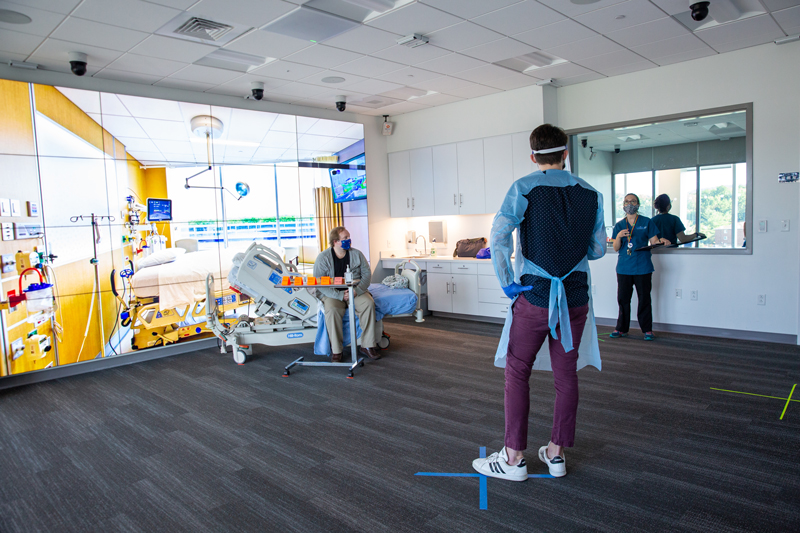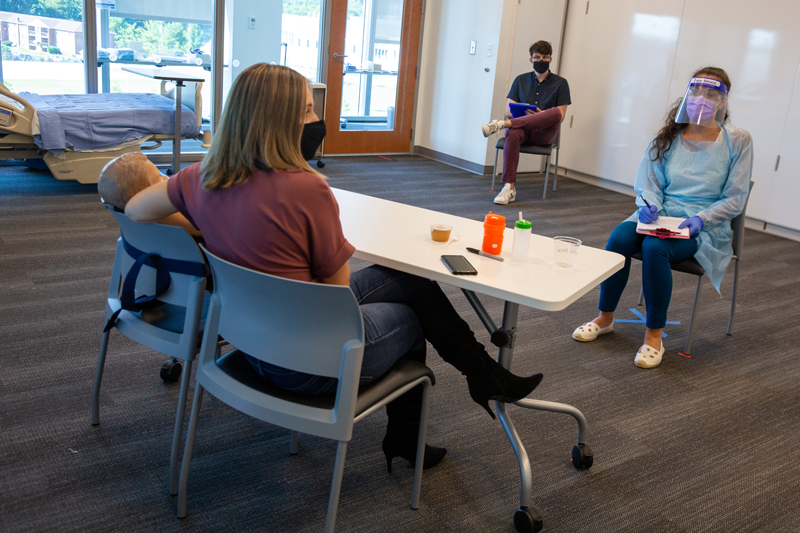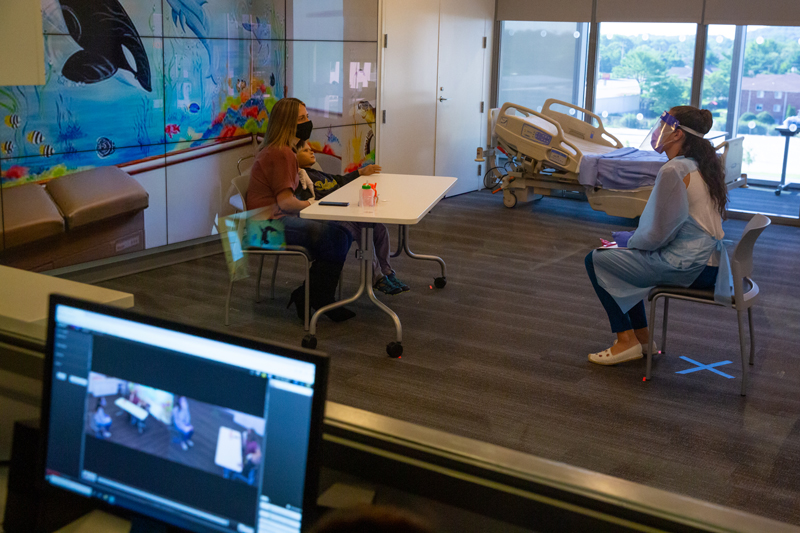


Healthcare Theatre during a pandemic
Photos by Ashley Barnas September 23, 2020
Telehealth, in-person COVID-19 scenarios help train future healthcare professionals
Despite the textbooks, lectures and study sessions, future health professionals can face many unknowns during their first interactions with patients. Will they ask the right questions? Will they know the right answers? How will they connect with their patients?
For the past 12 years, students at the University of Delaware have been able to safely practice their technical and interpersonal skills in a safe environment through the Healthcare Theatre program. Healthcare Theatre trains students to portray patients and family members for interactive, high-fidelity, simulation-based education experiences.
Thinking on your feet, responding quickly and being able to handle stressful situations are critical skills for both actors and healthcare professionals. Earlier this year, with the coronavirus disrupting its typical simulation scenarios, Healthcare Theatre decided to use the pandemic as a one-of-a-kind teaching opportunity.
The program transitioned from in-person simulations to telehealth, tweaking some of its scenarios to better fit a virtual setting while still giving students the chance to practice their skills — and perhaps pick up a few more through the use of telehealth.
Now, as healthcare professionals around the globe navigate the return of in-person visits, Healthcare Theatre has pivoted again to help UD students interact face-to-face with patients despite social distancing, personal protective equipment and other challenges brought on by the pandemic.
“Regardless of whether it’s done in person or virtually, these learning experiences are going to carry our students into their professional lives,” said Amy Cowperthwait, a co-founder of Healthcare Theatre. “This is a unique opportunity to practice direct care and learn how your patients are thinking and feeling.”

Simulation-based education integrates trained participants to portray the roles of patients and family members in a standardized way so healthcare professionals can practice important interpersonal and technical skills, such as taking a patient history.
At UD, students are trained to portray simulated patients and family members experiencing depression, pregnancy, drug use, cystic fibrosis and other patient presentations. Actors use disease details and their own research to deepen the characters they are portraying.
“As an aspiring healthcare worker, I was immediately drawn to the chance to be in the patients’ shoes.,” said Zoe Jacobson, who has spent four semesters with Healthcare Theatre, most recently as an intern. “It’s something that has reshaped the way I communicate with others.”
Heather Mekulski, program coordinator for Healthcare Theatre, said the authenticity created in the simulations gives students insight into the patients that they might not otherwise get in a clinical environment.
“It’s really the biggest opportunity for the healthcare learner to be able to hear from the patient, family member, or provider they are interacting with,” said Mekulski, who portrayed the mother of a child with a swallowing disorder during a recent simulation at UD’s Science, Technology and Advanced Research (STAR) Campus. “You’re not going to stop in a session and say, ‘How am I doing?’ It’s really the only opportunity they will get to practice and hear from someone who is totally emotionally attached to the patient they are portraying.”
In addition to developing scenarios for UD students studying nursing, physical therapy, health coaching, nutrition and business, Healthcare Theatre also works with healthcare professionals from several regional healthcare systems, including ChristianaCare, Nemours/Alfred I. duPont Hospital for Children, Sidney Kimmel Medical College at Thomas Jefferson University, Beebe Medical Center and the Wilmington VA Medical Center.

Although the program has grown in recent years — adding classes and working with departments in four UD colleges — the coronavirus (COVID-19) pandemic has created the biggest opportunity for Healthcare Theatre to expand its offerings, said Allan Carlsen, co-founder of the program and an assistant professor of theatre.
Working with faculty, Healthcare Theatre rewrote in-person patient scenarios so simulated participants could participate in virtual simulations using Zoom. Doing so has allowed participants to explore some of the challenges of telehealth, such as lighting, poor internet connection and sound quality. Some obstacles remain the same — being able to emotionally connect with a patient, asking the relevant questions, and confirming patient understanding.
“We had to teach simulated participants how to appropriately portray their character in a virtual setting,” Mekulski said. “This includes lighting, scenery, attire and even how technologically savvy the patient would be.”
Simulated patients and family members continue to play their part online. For example, a hungover student still slumps in a chair with an oversized sweatshirt. Non-verbal gestures like twiddling thumbs or wringing hands are exaggerated. Tissues are placed by the computer screen so a practitioner can virtually offer one to a patient, who in turn, shows one on their screen.
“Putting it in a virtual COVID world teaches them to work in a telehealth setting,” Carlsen said.
Healthcare Theatre has partnered with the Clinical Health Coaching certificate program for seven years to help health coaching students better understand what it’s like to coach a patient in real time. In addition to simulated participant integration for their final exam, Healthcare Theatre actors are used for a “master class” that allows beginning students to stop in the middle of the simulation to ask for advice or help.
“My students will always say it was the thing they were most nervous about, but they got the most out of the master class,” said Tara Leonard, director of the Clinical Health Coaching Research and Training Center. “In the middle of it you can say, ‘Wait a minute, I feel lost here so what do I say?’ Allan can offer advice, we can offer advice, another student can pop in and say, ‘How about trying it this way?’ It’s a really safe space to fall forward.”
Transitioning the master class to telehealth meant reworking the simulation — which featured a 23-year-old woman with unhealthy eating habits and limited exercise — to include her reasons for reaching out for a telehealth visit. To further amplify the development of the virtual scene and reinforce their role as a provider, health coaching students were encouraged to dress professionally. Just as in the in-person simulation, students received feedback from others in the class, including the actor portraying the patient.
Leonard said the pivot to online simulation allowed the students to get the coaching experience they needed while also picking up additional skills in telehealth. “I’ve had six finals since COVID,” she added. “We’ve had our foot on the gas working with Healthcare Theatre. We never stopped.”
On-campus learning
In early August, graduate students in the Communication Science and Disorders speech language pathology program donned surgical gowns, goggles, masks and other personal protective equipment. They stood socially distanced across the fourth floor of the Tower at STAR, waiting for their turn in the first face-to-face simulations in nearly five months. The day-long simulations had been planned weeks in advance with extra attention focused on safety protocols that were embedded into the simulation.
Walking into the Visualization Lab for Interprofessional Education and Research, students found themselves immersed in simulated hospital and outpatient rooms. They met Healthcare Theatre actors portraying patients and family members needing assessment and treatment of swallowing disorders known as dysphagia.
On one side of the partitioned room, Mekulski sat with a realistic child mannequin operated by a staff member in the adjacent control room. Mekulski portrayed, “Amber,” the mother of Andrew, a 3-year-old boy with Down syndrome and feeding problems. On the other side, actor Zachary Jackson sat in a bed as “Paul,” someone waiting to talk with someone about liquids he could drink following his discharge from the hospital.
Clinicians and faculty watched from the control room as the students, covered nearly head to toe with protective equipment, asked the patients about their swallowing problems. In addition to navigating the technical challenges of the diagnosis, students also had to figure out the best ways to interact with the patients, like speaking louder to make up for the muffled effect of the masks or offering feeding techniques while keeping social distancing in mind.
Afterward, simulated participants and faculty offered their feedback to the students, many of whom were sweating while wearing the extra protective layers. In one simulation, Jackson — speaking as “Paul” — noted the student didn’t introduce himself when coming into the room, which initially made him feel uncomfortable. But the student’s recap of the visit at the end of the appointment helped ease the tension.
“How is it talking through a mask?” Carlsen asked. “It’s hard when you can’t show half your face.”
Everyone in the room nodded.
Julie McCauley, a lead master clinician in the UD Speech-Language-Hearing Clinic who oversaw students in the simulation, said the face-to-face experience was an eye-opener for many students.
“These students definitely left with a new respect for what healthcare workers are going through right now,” she said. “And, I think they learned an unexpected lesson in how to be an empathetic practitioner, talking about ways to build rapport with a patient amidst layers of PPE.”
These kinds of experiences will lead to better healthcare providers, said Cowperthwait.
“Healthcare is pretty inflexible, but with the addition of the theatre perspective, that’s where we can be flexible and stretch learners of all kinds to the edges of their ability,” she said.
Contact Us
Have a UDaily story idea?
Contact us at ocm@udel.edu
Members of the press
Contact us at 302-831-NEWS or visit the Media Relations website

